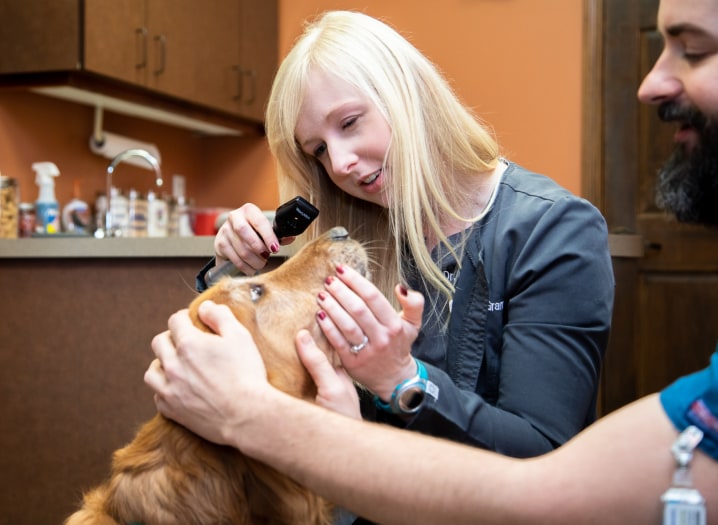At Western Carolina Regional Animal Hospital & Veterinary Emergency Hospital in Flat Rock, our veterinarians diagnose and treat eye and eyelid (ocular) disorders for dogs and cats.
Ocular procedures for cats and dogs
Ocular procedures involve the eye and eyelid.
At Western Carolina Regional Animal Hospital & Veterinary Emergency Hospital, we diagnose and treat many ocular conditions for cats and dogs, including eyelid tumor removal, cherry eye surgery, exenteration of the orbit, ectropion surgery, and entropion surgery.
With our leading-edge equipment, we can perform non-specialty ophthalmic surgical procedures, ophthalmic examinations, and diagnostics at our Flat Rock facility.

Common Eye Problems in Pets
- Vision Loss
- Glaucoma
- Cataracts
- Eyelid Issues
- Tumors
- Auto-Immune Conditions
- Drainage Corneal Ulcers
- Dry Eye
- Drainage
- Infections
- Abrasions and Scratches
- Retinal Disease
Ophthalmology FAQs
- What are the most common symptoms of eye problems for older cats and dogs?
- Redness
- Pain
- Cloudiness in Corneas
- Increased Tear Production
- Dilated Pupils
- Obviously Enlarged Eye
- Visible Third Eyelid
- If my cat or dog has something in their eye, what should I do?
Start by trying to remove the material or object by using a saline solution to flush your pet's eye. However, if your pet is in pain, this may prove difficult to do.
Never attempt to remove the object using your fingers, and especially avoid using tweezers, as both of these could seriously damage their eye.
If flushing the object out by yourself is impossible, bring your pet in to your veterinarian immediately to avoid complications or unnecessary pain.
- Should my pet have cataract surgery?
Not all cataracts will need surgery. In numerous cases, cats and dogs with cataracts are not seriously impacted by the opacity on their eye, and their vision remains good. A veterinary opthalmologist will need to determine if a specific patient needs cataract surgery. This is typically only in cases where the cataract seriously affects your pet's vision.
If your pet has a serious cataract and surgery is recommended, it will greatly improve their quality of life. While cataract surgery is not life-saving, it does help to restore their vision. For a pet experiencing blindness, seeing their owner again, looking out the window, and playing with toys can be life-changing for the patient and their owner.
This proves even more true with pets with hearing issues, elderly pets, or those suffering from cognitive problems or dementia.
- What is cherry eye?
Dogs have two visible eyelids, and a third is usually hidden in the inner corner of the eye. This third eyelid contains a gland that generates tears. The gland is not typically visible, but in dogs with congenital weakness of the ligaments that keep it in place, it can shift out of its rightful spot and become visible. It will look similar to a 'cherry' at the eye's inner corner.
To remedy cherry eye, a vet will perform a simple surgery to attach the gland to its proper location.
- My dog has eyelids that roll inwards (Entropin). What can be done?
Dogs whose eyelids roll inwards suffer pain each time they blink, because the hair is rubbing on the surface of the eye. This also results in increased tear production. This condition will eventually cause damage to a dog's cornea if left untreated.
Occasionally, Entropion will occur as a result of another condition and will resolve once the underlying issue is gone. In these scenarios, your vet can temporarily suture your pet's eyelids so they stay in a more natural position. In cases with permanent eyelid abnormalities, surgery may be needed.
